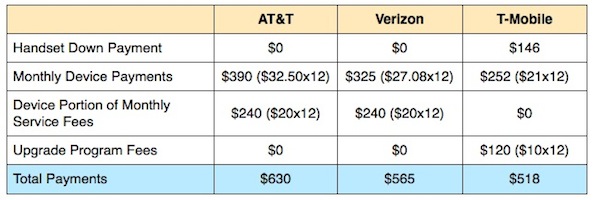We’ve already done the math on AT&T’s Next plan, and it’s not that great of a deal. Monthly payments equal to 1/20 of the device’s retail cost, on top of rate plans with built-in subsidy charges, means you’ll pay almost full retail for a device in 12 months and not get to keep it.
Verizon’s new Edge program works in a similar fashion, but the device’s retail cost is spread over 24 months. So you’ll pay about $28.08 per month for an iPhone 5, again in addition to roughly $20 of built-in subsidy charges, and you have to trade it in at the 6 month mark.
Confused? Here, the folks over at MacRumors put together this great chart to help explain it. It breaks down the different device upgrade plans for AT&T, Verizon and T-Mobile based on what device payments would be for a 16 GB iPhone 5 owner upgrading after 12 months.
As you can see, T-Mobile comes out substantially cheaper—over $100 cheaper than AT&T. This is due to the fact that it has completely decoupled handset purchases from service charges. By not including built-in subsidies in its rate plans, it makes them far less expensive.




